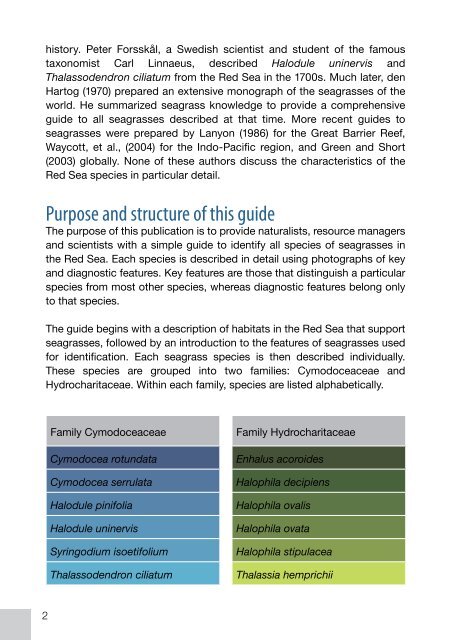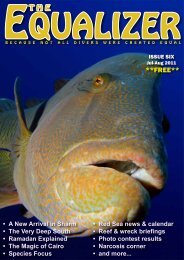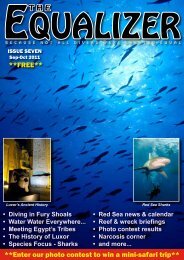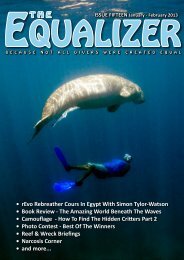Field Guide to Seagrasses of the Red Sea - Seagrass-Watch
Field Guide to Seagrasses of the Red Sea - Seagrass-Watch
Field Guide to Seagrasses of the Red Sea - Seagrass-Watch
Create successful ePaper yourself
Turn your PDF publications into a flip-book with our unique Google optimized e-Paper software.
his<strong>to</strong>ry. Peter Forsskål, a Swedish scientist and student <strong>of</strong> <strong>the</strong> famous<br />
taxonomist Carl Linnaeus, described Halodule uninervis and<br />
Thalassodendron ciliatum from <strong>the</strong> <strong>Red</strong> <strong>Sea</strong> in <strong>the</strong> 1700s. Much later, den<br />
Har<strong>to</strong>g (1970) prepared an extensive monograph <strong>of</strong> <strong>the</strong> seagrasses <strong>of</strong> <strong>the</strong><br />
world. He summarized seagrass knowledge <strong>to</strong> provide a comprehensive<br />
guide <strong>to</strong> all seagrasses described at that time. More recent guides <strong>to</strong><br />
seagrasses were prepared by Lanyon (1986) for <strong>the</strong> Great Barrier Reef,<br />
Waycott, et al., (2004) for <strong>the</strong> Indo-Pacific region, and Green and Short<br />
(2003) globally. None <strong>of</strong> <strong>the</strong>se authors discuss <strong>the</strong> characteristics <strong>of</strong> <strong>the</strong><br />
<strong>Red</strong> <strong>Sea</strong> species in particular detail.<br />
Purpose and structure <strong>of</strong> this guide<br />
The purpose <strong>of</strong> this publication is <strong>to</strong> provide naturalists, resource managers<br />
and scientists with a simple guide <strong>to</strong> identify all species <strong>of</strong> seagrasses in<br />
<strong>the</strong> <strong>Red</strong> <strong>Sea</strong>. Each species is described in detail using pho<strong>to</strong>graphs <strong>of</strong> key<br />
and diagnostic features. Key features are those that distinguish a particular<br />
species from most o<strong>the</strong>r species, whereas diagnostic features belong only<br />
<strong>to</strong> that species.<br />
The guide begins with a description <strong>of</strong> habitats in <strong>the</strong> <strong>Red</strong> <strong>Sea</strong> that support<br />
seagrasses, followed by an introduction <strong>to</strong> <strong>the</strong> features <strong>of</strong> seagrasses used<br />
for identification. Each seagrass species is <strong>the</strong>n described individually.<br />
These species are grouped in<strong>to</strong> two families: Cymodoceaceae and<br />
Hydrocharitaceae. Within each family, species are listed alphabetically.<br />
Family Cymodoceaceae<br />
Cymodocea rotundata<br />
Cymodocea serrulata<br />
Halodule pinifolia<br />
Halodule uninervis<br />
Syringodium isoetifolium<br />
Thalassodendron ciliatum<br />
Family Hydrocharitaceae<br />
Enhalus acoroides<br />
Halophila decipiens<br />
Halophila ovalis<br />
Halophila ovata<br />
Halophila stipulacea<br />
Thalassia hemprichii<br />
2





